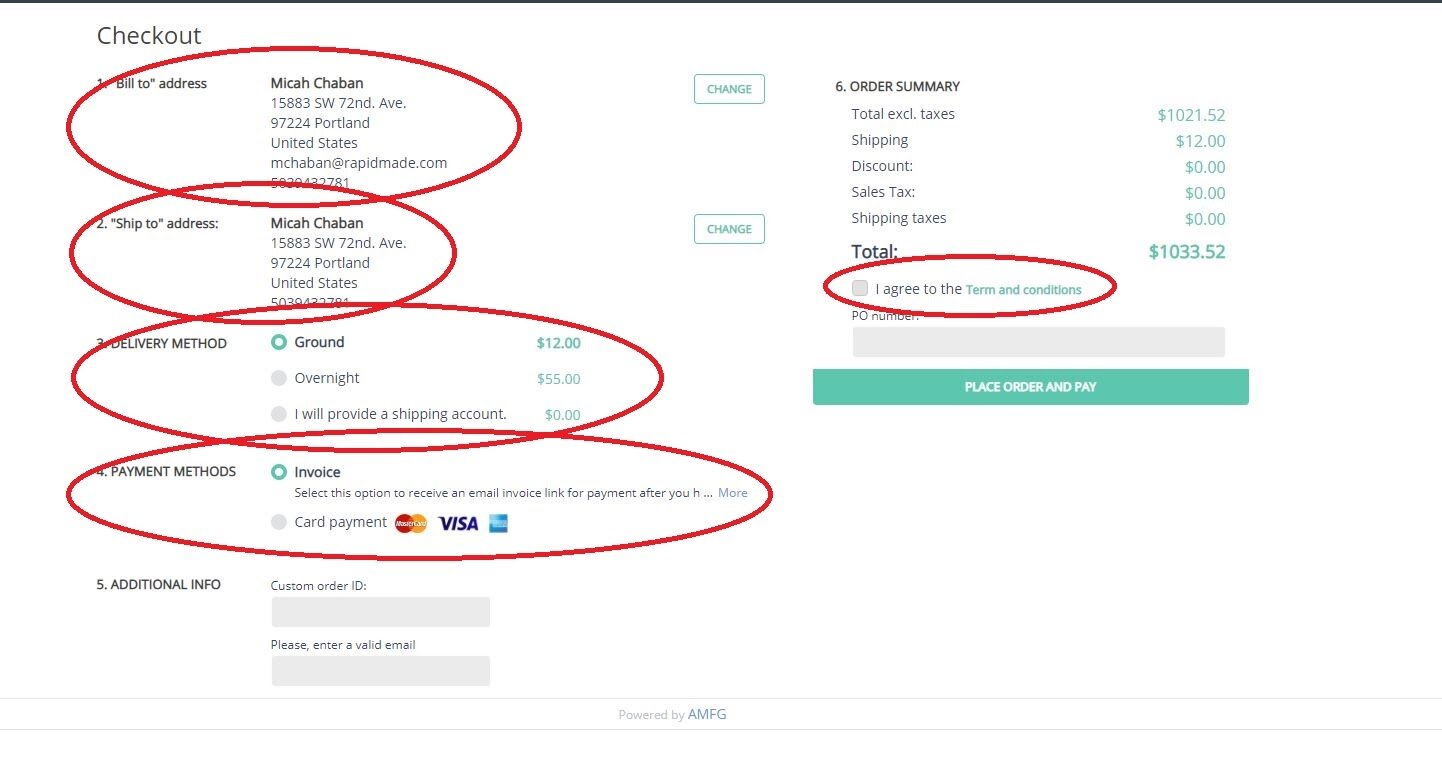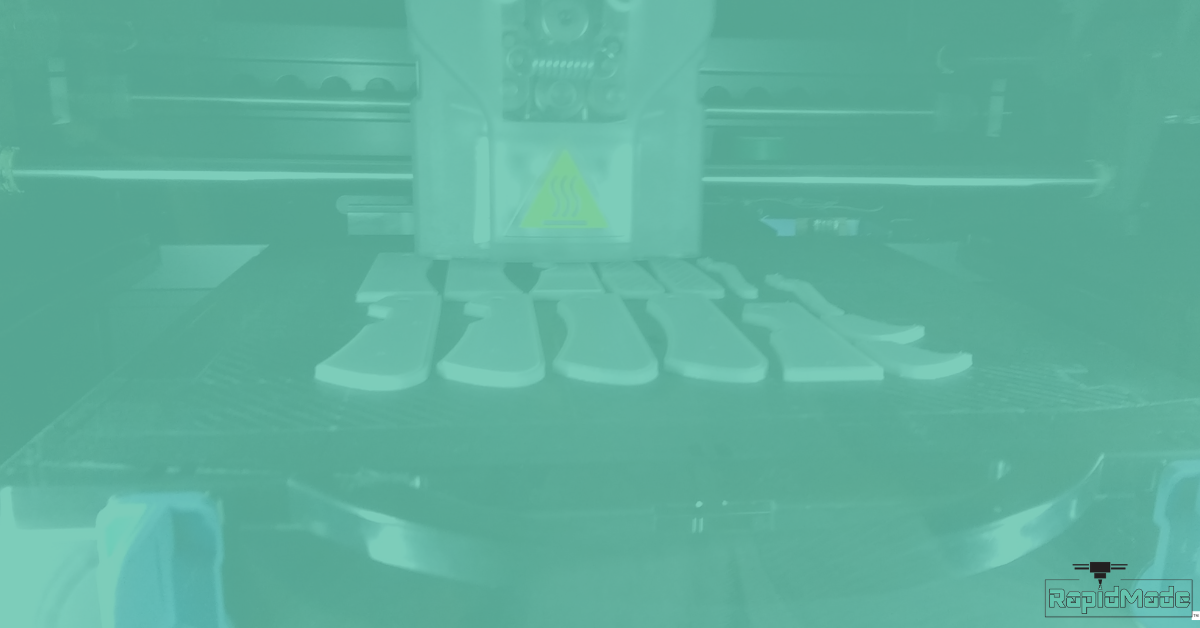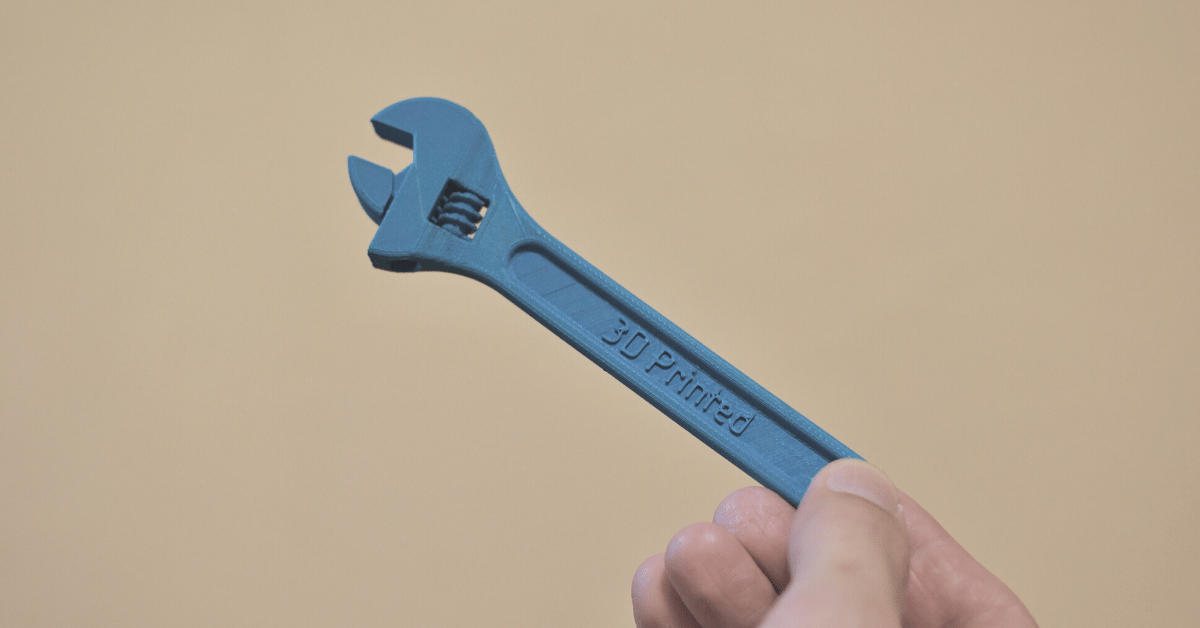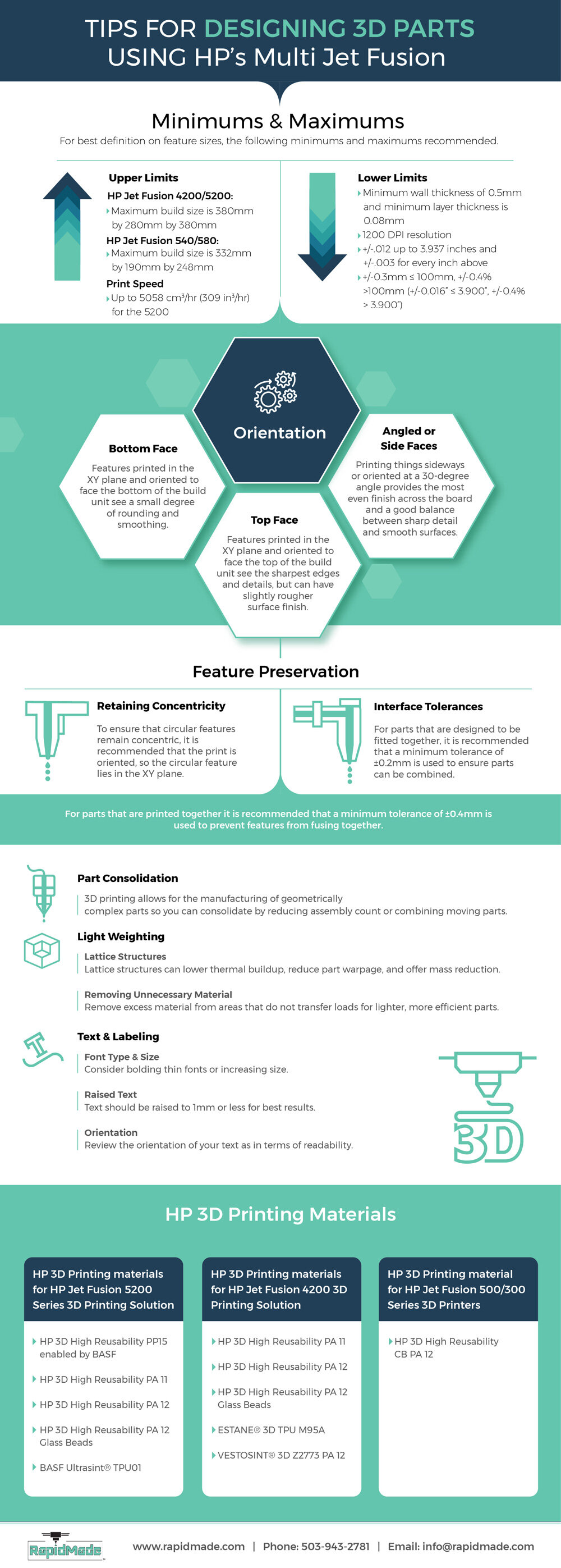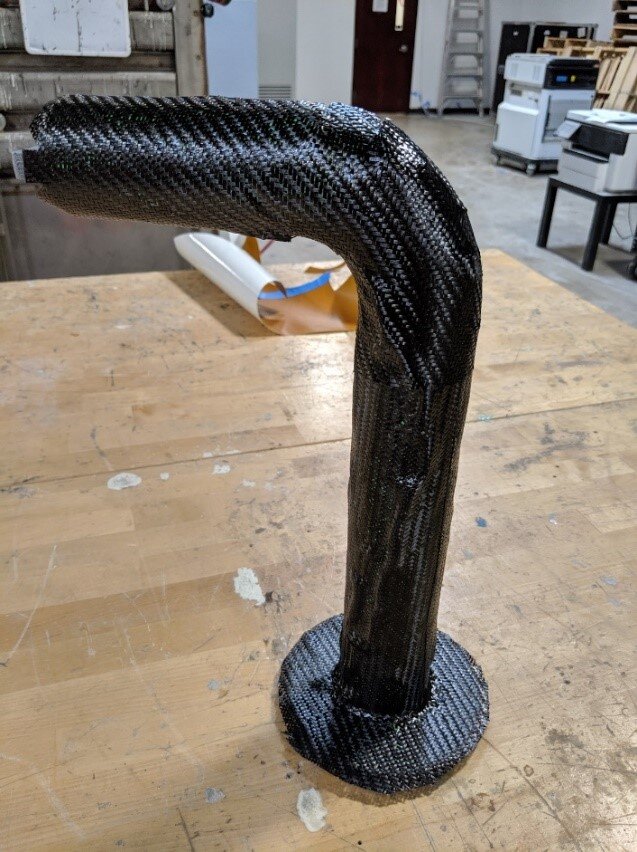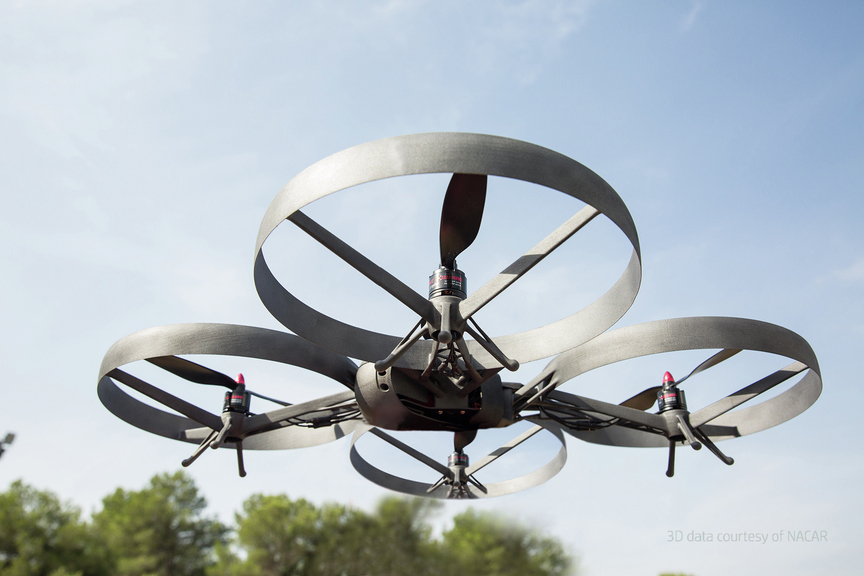Formed to hold specific items, a thermoformed tray can be molded to hold anything as opposed to needing to find containers to hold an item.
Why Work with RapidMade As Your 3D Printing Partner
We are more than just a manufacturer, engineering service or 3D printer; we treat every project as if it were our own – with the utmost care and attention to detail. Why? Because every business has its own unique drivers, goals, and needs – and your projects deserve to be custom-tailored to exceed your expectations.
How to Use RapidMade’s 3D Printing Instant Quote Tool
With today’s growing consumer demand, instantly ordering 3D prints and quickly manufacturing metal and plastic parts can make or break your business. Because of the fast-paced nature of our competitive landscape, we wanted to devise a simple solution to help businesses maintain the forward momentum. That’s why we’ve created our new Instant Quote Tool, which gives you the ability to quote and order high-quality 3D prints with a few clicks of your mouse.
3D Printing Instant Quote Tool: 5 Steps
1. Visit https://www.rapidmade.com/instant-quote and Create An Account
2. Select Instant Quote button
3. Drag and Drop CAD file
4. Select Correct Units, Technology, Material, Color, Production Time, and Quantity.
Add to Cart and Submit.
5. At Checkout, confirm your “Bill to,” Ship to,” “Delivery Method,” “Payment Method,” and read and agree to our terms before checking out
How to Use Our Instant Quote Tool
We’ve created a streamlined process for convenience, ease-of-use, and speedy results. There’s a low order minimum of $95 correlated with using our Instant Quote Tool, and you’ll enjoy a 15% discount on printed parts. The tool even saves parts for easy re-order later.
Our Instant Quote system is compatible with most CAD files, including SLDPRT, STL, IGES, STEP, and more. Additionally, some of the industry’s most sought-after 3D printing technologies are available at your disposal, including:
Apologies to customers interested in Colorjet and Polyjet services. Due to the high cost of maintenance and low demand, we have taken those machines offline. Please stay tuned for new machines coming online next year to replace our full color and high-resolution offerings.
All you need to access the tool is to create an account with us (if you haven’t already). Once logged in, simply upload your CAD files to the system. It’s important to note that parts with dimensions greater than a given printer’s bed size will have to be assembled and glued together from multiple components that were printed separately. For hollow parts, outlet holes will be included to allow for the release of support material.
Please also note on the left side of the screen that the correct units are being used. STLs do not specify if the units are in inches or millimeters so customers need to call that out. Not checking for this could result in a part that is 25.4 times too large or too small.
Once your model is uploaded and the correct units and technology are selected, you can edit other features of your order, including Color, Lead Time (Standard or 2 business day rush, where available,) Material, and Quantity.
When uploading a file, please refrain from placing multiple bodies in the same file. Not only will it cause processing to become incredibly intricate for the shop, but parts that are too close to one another will fuse together. It is best to let RapidMade technicians decide how to place and process individual body files. Large files may take time to process and files over 50 mb will not upload.
Each technology has very strict design guidelines that vary from other technologies. Before ordering in your desired technology and material please make sure you follow those guidelines listed on the instant quote page below at the bottom. Orders that do not follow our design guidelines will be rejected. These design guidelines include minimum wall thicknesses, tolerances, and print sizes.
Once you have added your order to the cart you can review your cart and checkout. During checkout please review your Bill and Ship To Addresses, Delivery Method (ship speed; ground, will call, overnight and 2 day,) Payment Method (Pay by credit card or invoice,) and agree to our Terms of Service.
Upon clicking Place Order and Pay you are all done if you paid by credit card. If you selected Pay by Invoice we will send you a secure email payment link or if you have payment terms with us you can submit a purchase order. Once the payment is complete your order will be accepted and you will receive an email order confirmation immediately as well as a scheduling email by the next business day.
IMPORTANT NOTE: Orders placed after 1PM PST Monday - Friday or on weekends will be initiated the next business day.
Access to 3D Printing On Demand
Ordering custom 3D prints has never been easier. After your file is uploaded, you’ll have the ability to view a 3D model of your part. From there, all you need to do is select your desired material and technology, insert the number of parts needed, and place your order. You even have the option to save your orders to come back and revisit at a later time. It’s really that simple.
Superior 3D Printing Partners, Backed by Quality Customer Service
You can rest easy knowing that all Instant Quote projects receive the same engineering expertise and top-notch customer service we devote to everything we do. We’re committed to supplying you with the product you need and ensuring it’s in your hands when you need it. If an unexpected hurdle or challenge arises, we’ll provide the personalized attention needed to help you tackle it with ease. That includes having access to our dedicated support staff to address product changes or questions you may have.
In our ever-evolving market, our goal is to help your company thrive and profit as business needs change and develop over time. Are you ready to get started? Visit our Instant Quote tool now!
What is Rapid Prototyping?
Rapid prototyping is the use of 3D printing to quickly put together a part, model, or assembly. Rapid prototyping can be used in many fields and can significantly reduce the manufacturing process. There are differences between a high fidelity prototype, which is a design that closely matches the finished product; and a low fidelity prototype is one that has a marked difference from the finished product.
How Effective is Rapid Prototyping?
Rapid Prototyping is most often utilized in layered additive manufacturing. That being said, rapid prototyping can be used for high-speed machining, casting, and extruding. The process of rapid prototyping was first utilized in the 1980s and has been integrated into manufacturing in the decades afterward. It has been a proven process that is more cost-effective, faster, and more accurate than other traditional methods of manufacturing.
The two types of rapid prototyping include:
Subtractive: This process includes a block of material that is carved in order to produce the desired shape. This is achieved by milling, grinding, or turning.
Compressive: A semi-solid or liquid material is forced into the desired shape before being solidified.
What Are The Advantages Of Using Rapid Prototyping?
As mentioned earlier, Rapid Prototyping requires less staff on hand to operate machinery. It costs less money than traditional ways of manufacturing. Rapid prototyping will also allow for a more accurate picture of what the final product would look like. Aiding in the manufacturing process and ensuring that things are done more efficiently than they may have been done without rapid prototyping.
What are the different types of rapid prototyping that are being implemented today?
Stereolithography (SLA)/Vat Photopolymerization
Fast and affordable, this method was the first successful method involving 3D printing. This method uses a bath of photosensitive liquid which is solidified by each layer, using a computer-controlled UV light.
Selective Laser Sintering (SLS)
SLS is used for both metal and plastic prototyping and uses a powder bed in order to build a prototype one layer at a time. While using a laser to heat and sinter the powdered material, the strength of the parts does not stand up to the strength of the SLA. The surface of the finished product is typically rough and often requires secondary work to complete it.
Fused Deposition Modelling (FDM) or Material Jetting
Incredibly inexpensive, FDM is an easy process and can be found in most non-industrial desktop 3D printers. The process of FDM uses a spool of thermoplastic filament. In general, the early results can have a poor resolution, but the process is being improved on. And considering it is the most inexpensive process, it is perfect for companies just starting off.
Laminated Object Manufacturing (LOM)/ Sheet Lamination
Another inexpensive process, it is less sophisticated than SLM or SLS. However, it does not require specially controlled conditions. LOM works by building up a series of thin laminates that have been accurately cut with laser beams. Each layer is created and layered on top of one another, being bonded together; until the part is complete.
Binder Jetting
Using a powder bed to spray micro-fine droplets to bind powder particles together, this technique may not produce products are strong as those created by using the SLS, but it does allow more than one part to be made at one time.
Rapid Prototyping Costs Vary, But Still a Better Option
For most or all fields, rapid prototyping is a beneficial process to speed up manufacturing and allow companies to have a quicker turnaround. It allows them to get a better picture of what their final product is. Interested in rapid prototyping? Request a quote today!
Commercial 3D Printing for Manufacturers
Are you a commercial manufacturer researching more about 3D commercial printing? Or, are you familiar with the technology, but interested in finding the right commercial 3D print partner? At RapidMade, we’re proud to be the commercial 3D print partner for hundreds of businesses nationwide. Regardless of where you are in the process, here are several questions surrounding the topic of commercial 3D printing that we’re frequently asked.
Interested in learning more about our equipment and processes? Get in touch with our sales team or submit a quote request!
The Basics: What Is 3D Printing?
3D printing is a process used to construct physical three-dimensional objects from a digital model. First introduced in the late 1980s, 3D printing technology drives product innovation, accelerates the product development cycle, and decreases manufacturing costs.
You may have heard the term additive manufacturing being used synonymously or with 3D printing. Additive manufacturing involves the process of joining materials to make models from 3D model data. As opposed to subtractive methodologies (removing pieces during manufacturing), additive manufacturing creates in a layer upon layer or additive process.
Which Materials Cannot Be Used for 3D Printing?
Theoretically, under the right conditions, virtually any material can be utilized in the 3D printing process. The most common materials used in commercial 3D printing include plastic, nylon, resins, metal, and polycarbonate materials. Our most popular 3D printed plastics include Nylon PA-12 for general purpose jobs, ABS for highest accuracy projects, and PMMA for large format printing.
Is the Quality of 3D Printed Products as Good as Those Manufactured Traditionally?
The answer to this depends on several factors, such as the type of product being printed. For example, a 3D printed kitchen knife likely won’t possess the same sharpness or edge as one authentically forged from steel. However, 3D commercial printing has opened the doorway for certain products, such as jet engine components, to be greatly improved because they aren’t confined by the limitations of traditional manufacturing.
Jet engine components are just one example of how 3D printing can be utilized for intricate inner channeling, which lends to a more fuel-efficient engine. This wouldn’t be possible through traditional methods of CNC milling. On an economic level, 3D commercial printing provides a cost-effective, resourceful, and highly efficient alternative that will likely surpass conventional processes in the future.
What Are the Benefits of 3D Printing Compared to Injection Molding?
Compared to injection molding, 3D printing provides significant cost advantages. For example, the injection molding process requires the formation of a mold, which can be delicate and costly. Additionally, a myriad of geometric shapes can be produced via 3D means, yet cannot be manufactured using injection molding. The type of manufacturing needed (3D printing vs injection molding) often is based on the volume required for the project.
What Is 3D Printing Good For?
On the commercial side of things, 3D printing has proven to be a valuable resource for a multitude of industries. From the automotive space to the healthcare landscape, 3D printing has served as a means for bringing products to market quicker and accomplishing things that were never before possible – like custom-built prosthetics and 3D printed human tissue.
3D printing is cost-effective for lower volume projects, is a quicker manufacturing process with turntimes in the days or weeks vs months, and allows for a lower volume of inventory. When it comes to the capabilities of 3D commercial printing – the applications, processes, and materials – industries across the gamut now have access to the technology needed to produce more cutting-edge, timely products. For a more comprehensive look at 3D printing, check out our guidebook here.
Commercial 3D Printing Is Paving The Way for Innovation
CASE STUDY: 3D Printing & Thermoforming Vehicle Parts
3D Printed Tooling Is Revolutionizing the Manufacturing Industry
Why Medical Device Prototyping is Essential for Creating a Market-Ready Product
HP Multi Jet Fusion - Tips for Designing 3D Parts
The 3D printing market is a rapidly growing industry. In fact, the market size of 3D printed products and services is estimated to reach $40.8 billion globally by 2024, more than double the current projected estimate of $19 billion for 2020.
With such high growth potential, businesses in the 3D printing industry need to learn everything they can to stay competitive. The first step to staying competitive is having an understanding of the tools and equipment.
The following infographic displays the technical aspects of the HP MJF 3D printing series. Here, you’ll find helpful information on the specs and capabilities of each model type as well as tips on orientation and preferred printing materials that can help you design and create the perfect 3D parts for your project.
RapidMade is your go-to resource for any and all things 3D printing services. If you’re looking for superior designing and prototyping for a project or looking for a manufacturer for production, our team of experts can help. Contact us today and request a quote!
RapidMade Masks Help You Face Flying
One of the most anxiety-ridden activities these days is flying. Even if face masks weren’t mandated, most travelers would gladly wear them to enhance their personal safety. In locations where physical distancing is more difficult, people often prefer something more robust than a simple cloth mask.
Our thermoformed, filter-based face masks were enthusiastically worn by one family on a recent flight.
These masks gave us the peace of mind we needed to fly during the COVID pandemic! The masks fit snugly, but are easily breathable. We wouldn’t have flown without the security these masks provided!”
These reusable face masks can be thoroughly sanitized between uses, and the filters can be replaced as needed. If you’d like to order, please click here.
RapidMade Develops Techniques to Strengthen 3D Printed Nylon Parts with Reinforced Fibers
Carbon-fiber-reinforced 3D Printed Nylon Part
RapidMade recently completed research on investigating a solution to produce custom agricultural parts from 3D printed nylon reinforced with fibers in epoxy polymers. The work was completed with Oregon State University and was funded with an SBIR grant from the USDA.
Additive manufacturing reduces the cost and lead time of individually produced parts. Most printed plastic materials lack the strength needed to replace metal parts. Synthetic and natural fiber reinforcement can increase the strength of these lighter plastic parts making them comparable to metal. Well characterized design and manufacturing processes are critical to produce reliable composite parts.
Research focused on:
· structural component designs including materials selection
· pilot manufacturing process development
· manufacturing and mechanical component property validation.
Outcomes identified possible techniques for component design and manufacture to:
· eliminate plastic part anisotropy
· control warp and residual stresses in composite components
· verify plastic/epoxy bond strength
· optimize print orientation
· improve fiber reinforcement application
· establish curing cycle and post-processing requirements.
Future research will study part design techniques to:
· determine best practices
· create structural and processing analysis rules
· explore different material options
· optimize manufacturing processes for small batch production
· evaluate aging and environmentally induced stress responses.
Component design and manufacture showed positive results in terms of low-cost manufacturing process and performance. Fiber-reinforced parts performed better than the plastic-only reference components with strength comparable to the original metal parts. Data suggest that a reliable method for engineering and manufacturing fiber reinforced composites using printed parts was found. Proof-of-concept agricultural and robotic parts that can replace obsolete and custom equipment were shown to be potential affordable alternatives to the originals. Design aspects like matching plastic core and fiber reinforcement characteristics for optimal final composite products need to be addressed in detail.
New composite alternatives can be used to:
· make replacement parts
· increase field productivity
· upgrade or reconfigure machinery
· improve equipment operations and efficiencies
· manufacture components using more sustainable materials
· enable local farms to be more independent in part procurement.
This manufacturing process can enable small production plants to make parts locally as needed. Future work should build on current results by studying custom design, materials selection, manufacturing process optimization and aging and environmentally induced stress responses. Specifically, research focused on bonding reliability between printed parts and fiber reinforcement and combining components in a simple, efficient composite manufacturing process.
Work was subdivided into the following areas:
Mechanical Properties and Anisotropy of 3D Printed Parts. Baseline tests measured printed part mechanical properties prior to testing composite fiber components. ASTM standard tests of mechanical properties and microscopic analysis across a range of printers identified part anisotropy. Print parameters were established to limit anisotropy. Additional design parameters must be developed to limit impact on composite part performance.
Characterization of the 3D Printed Plastic-Fiber Reinforcement Epoxy Bond. Detailed bond tests were performed on parts made using two different fabrication techniques and three alternate fibers. Single lap joints were shear tested to failure to study nylon composite bond response. Multiple test scenarios characterized the nature of the bond, the minimum overlap requirements and the relative results with different fiber materials. Part failure occurred before the bond confirming the hypothesis. Actual bond strength data was captured. The use of organic fibers as an alternative lower cost composite reinforcement was confirmed.
Composite Manufacturing Process Evaluation. An established composite manufacturing process employed for small batch production was used for testing. Research focused on adapting these techniques to printed materials. Successful composite test parts were created and used for mechanical properties testing. Elements of the composite manufacturing process were investigated to improve the epoxy-nylon bond and to minimize component stress during heat curing. Trials were conducted to further simplify manufacturing techniques and optimize part quality. Work focused on three test components and three alternate fiber reinforcement materials. Iterations evaluated manufacturing process and part quality improvements. Findings were summarized in the published research.
Warping of Components During Curing. The effects of bonding between thin wall printed parts and fiber reinforcement using different configurations was studied. Thin wall components and the ability to assemble larger composite parts from multiple smaller printed parts are critical requirements for farming applications. The work focused on composite cooling times and fiber direction. Non-traditional inverse core sandwich constructions were also studied and tested. Results were positive; additional work will focus on further internal part stress reduction.
Design of Fiber-reinforced Test Components: Three designs were tested: a tractor linkage arm, a compound moment arm and a robotic fruit picker. These parts were selected as they experience different operational compressive and tensile stresses. The fiber reinforced parts were dimensionally comparable to the original metal parts. Mass reduction and low-cost manufacturing were assessed.
Construction and Testing of fiber-reinforced, 3D printed composite parts: Baseline finite element analysis for loading and elastic deformation simulations was performed on part designs. Unreinforced printed parts were mechanically loaded and tested; experimental results were compared to the simulations and test part baselines were created. Loading tests were repeated using fiber reinforced composite parts to characterize mechanical property augmentation due to fiber-reinforcement and the overall part performance. Extensive testing was conducted on all three parts using a range of fiber materials. The results were cataloged and contrasted to establish performance models. The work also analyzed the impact of composite construction methods on finished part mechanical properties.
Impact of temperature cycling on fiber-reinforced, 3D printed composite parts: Cyclical temperature tests performed on all parts using multiple fiber materials determined fiber bonding impact. This work measured bonded composite delamination using non-destructive test methods. Results confirmed that printed part design and fiber reinforcement location can impact composite bonding in response to thermal stress. Minimum printed part thickness must be determined to minimize warping, during the initial curing process and in response to subsequent thermal stress. Printed parts need to be designed and manufactured to account for internal thermal stress factors. Design techniques to improve part structural strength properties need to be included in future work. Finally, reinforcing composites should be selected to have a coefficient of thermal expansion that matches the printed core to minimize thermal stress warping.
To read the complete technical research report go to https://www.rapidmade.com/resources
Because One Size Doesn't Always Fit All
Filtered Face Masks Now Come in Large and Small Sizes
To provide a better fit for smaller profiles, RapidMade now makes filtered face masks in small as well as large sizes. Adjustable straps allow wearers to secure the masks behind their heads or loop around their ears.
Masks: Face masks are made from durable, rigid plastic with comfortable silicone seals where they contact the face. Replaceable filters fit snugly within the mask opening. Masks can be cleaned with disinfectant. Replacement filters sold separately in packs of 4 (see below.) Adjustable straps with multiple sizes fit any face.
Filters: Medical-grade filters and gauze sandwiched in a rigid nylon frame. MBN95—53100 synthetic media (95% EFF) rated at 98% BFE is based on living organisms 1-5 microns. PFE is based on dead particles from 0.1-1 micron.
*LEGAL DISCLAIMER: This mask is not an FDA-cleared PPE and is not intended to replace an N95 respirator. It may not provide the same level of barrier protection, fluid resistance, filtration and infection control. Users should check the mask's seal for leaks, confirm that they can breathe through the filter material, only use filters that are rated to filter out at least 95% of very small (0.3 micron particles), exercise caution in surgical environments where the need for liquid barrier protection and flammability is a concern, recognize that the mask may not provide air filtration enough to prevent transmission of infectious agents, safely dispose of infectious materials and disinfect any part they intend to reuse. Users are encouraged to wear a face shield over the mask to provide additional protection.
RapidMade is fabricating High-Quality PPE for COVID-19 - Masks, Filters & Face Shields
We’ve all heard the stories about the PPE shortages, and, like everyone, we want to ensure people who need PPE can get them. So we’ve converted some of our production facilities to support the emergency response. In addition to donating where we can, we are now offering to sell PPE to interested parties. Visit our COVID-19 PPE Fabrication page for more information on prices, availability and how to order. Stay safe!
RapidMade is Hiring...
Shop Technician (Tigard)
RapidMade, a 3D printing and engineering services firm located in Tigard, has an opening for a Shop Technician. The starting wage is $16 - 18/hour, depending on experience and the work schedule is Monday – Thursday or Tuesday - Friday on its 7 AM – 5 PM or 9 AM - 7 PM shift. New hires may be trained to perform all job duties.
RESPONSIBILITIES:
• As directed, performs thermoforming, CNC machine programming, casting, mold making, painting and finishing duties.
• Completes assigned production orders. Ensures orders are delivered on time, below cost, and meet customer specifications and quality requirements.
• Provides feedback to Shop Supervisor on order and shipment status.
• Utilizes work flow software as directed.
• Maintains work area as needed to ensure workplace safety and quality output.
• Other duties as assigned.
JOB REQUIREMENTS:
• High school degree or equivalent experience in related field.
• Adapts to changing customer requirements and operates in a fast-paced environment.
• Good communication, interpersonal skills, and able to handle multiple priorities.
• Meets job-specific physical requirements.
• Follows all safety and quality-related work procedures.
• Manufacturing experience preferred.
BENEFITS:
• Paid holidays
• Vacation/PTO
• Monthly Production-Related Bonuses
• Medical Insurance offered to full-time employees
Contact jobs@rapidmade.com
Multi Jet Fusion Rubber Printing Is Here
3D printed rubber just got a major upgrade with the addition of durable, rubber-like thermoplastic polyurethane (TPU) to the Multi Jet Fusion’s roster of materials.
Now you can print strong, detailed and affordable rubber parts in a fraction of the time and cost of other 3D printing technologies like FDM and SLS. With its high chemical, thermal and abrasion resistance, TPU is the perfect material for common rubber parts like seals, gaskets and hoses.
Join Oregon Chapter of Women in Manufacturing Networking Night
End your day with appetizers, refreshments and conversation!
Join WiM Oregon for our upcoming Networking Night. This is a great opportunity for manufacturing professionals at all levels to network over appetizers, and to discuss December fundraising opportunities for WiM Oregon.
No matter what level you are in your manufacturing career, we look forward to meeting with you.
Date:
Tuesday, November 12
Time:
5:00 PM - 7:00 PM
Location:
Delap LLP
5885 Meadows Road
Lake Oswego
We hope to see you there!
Student: Free
WiM Member: Free
Nonmember: Free
Check Out Our New 3D Printing Guide
We’re always trying to improve and update our public resources on 3D printing. As quickly as the technologies are evolving, it can sometimes seem impossible to keep up. That’s why we recently published our Complete Guide to 3D Printing.
Our goal with this guide was to make the most up-to-date and comprehensive resource available on 3D printers, materials, design principles, and 3D printing’s place in modern manufacturing supply chains.
In it, you will find detailed descriptions of all 3D printing technologies on the market as well as comparisons with other types of manufacturing like machining and injection molding.
3D printing has come a long way from its origins as a technology primarily oriented toward prototyping. New plastic and metal 3D printing processes like HP’s Multi Jet Fusion and ExOne’s direct material printing allow us to quickly produce low- to medium-volume production runs of industrial-strength parts in a fraction of the time and at a fraction of the cost of traditional manufacturing.
When it comes to 3D printing, the manufacturing world is only just beginning to explore what is possible. To learn more about how design for additive manufacturing (DfAM) is reshaping modern industry, check out our design for additive manufacturing guide.
By providing more information on 3D printing, we hope to enable the next generation of innovation to continue to push our understanding of what is possible with these technologies.
If you have any questions or things you’d like to see included in future guides, leave a comment or get in touch with us directly. We love to hear from you!
Increased 3D Printing Capacity Is Here
Three years ago, the HP Multi Jet Fusion 3D printer redefined additive manufacturing. While 3D printing has always been a great technology for rapid prototyping and product development, MJF made it possible to 3D print small- to medium-sized production runs of high-quality, industrial-grade nylon parts for the first time ever.
We immediately saw the value this could provide to our customers, which is why RapidMade became one of the earliest adopters of MJF 3D printing technology. Our Multi Jet Fusion products quickly became the cornerstone of our manufacturing services.
Now, we are pleased to announce that we have recently doubled our MJF printing capacity with upgraded Jet Fusion 5200-Series machines.
Bigger and better
This increased capacity means that we will have twice the availability for fast turnarounds and high volumes to accelerate your production and increase your competitive advantage.
Whether you are looking to quickly iterate prototypes for enhanced product development, create a smooth transition into full-scale manufacturing, or support existing products with custom replacement parts, Multi Jet Fusion 3D printing offers the best solution on the market.
And with the new 5200-Series machines, we can offer enhanced cooling options for greater accuracy and fine control, giving you unprecedented repeatability for industrial 3D printing. Not only that, but the 5200’s shorter downtime and lower labor requirements mean the best value in manufacturing just got even better.
The advantages of MJF 3D printing
If you haven’t experienced the benefits of MJF 3D printing, here are just a few things to consider:
Save weeks of time and tens of thousands of dollars by ditching the expensive tooling and setup costs of injection molding or machining.
MJF 3D prints ship in as few as two days.
Seamlessly adjust product designs with no downtime or additional cost.
Easily produce complex geometries like lattices, nested cores, and hollow spaces that would be impossible to create with traditional technologies.
Combine multi-part assemblies into single parts, saving on post-production assembly and improving function.
Create lightweight products without sacrificing strength or durability.
RapidMade is here for your business
We’re growing our business to help you keep growing yours. Our improved 3D printing services will still be backed by our high-quality customer service and engineering. We’ll take the time to understand your needs and work with you to develop the best manufacturing solution for your project, every time.
If you’d like to see what Multi Jet Fusion printing and RapidMade can do for your business, get a Classic Quote today in 24 hours or less, or use our Instant Quote tool today to quote and order parts right away. All you need is a CAD File!
Still have questions? Reach out to us directly at info@rapidmade.com or give us a call at (503) 943-2781. We’d love to hear from you.
We’re Doubling Our MJF 3D Printing Capacity
We launched our Multi Jet Fusion 3D printing service last year to provide our clients with the best 3D printing technology for small- to medium-sized production runs and functional prototypes. The response surprised even us!
It turns out that people really like high-quality products, great value and fast turnaround—which is why we’re doubling our MJF printing capacity with brand new Multi Jet Fusion 5200 Series machines.
We’ll still be providing the same great customer service and high-quality manufacturing—just twice as much of it. From product development and initial production to replacement parts and more, RapidMade and MJF 3D printing provide unmatched value throughout your product life cycle.
The Best General-Purpose 3D Printing
If you don’t already know, HP’s Multi Jet Fusion is the fastest industrial-grade 3D printer on the market. It prints durable nylon PA-12 parts and prototypes with lead times as small as two days—without the expensive tooling and setup costs of injection molding and machining.
With MJF printing, manufacturing complex designs is a breeze. Features like lattices, hollow bodies or nested cores that would be prohibitively expensive or downright impossible to produce with traditional technologies are fast and economical to 3D print.
Whether you want to reduce part weight, combine multi-part assemblies into a single piece or simply reduce your material costs, the possibilities are endless. MJF technology has made it easy to develop products and transition into full production runs all in one place.
Get Ready for an Upgrade
The upgraded 5200 Series has improved cooling cycles for even more reliable fine control, better repeatability and enhanced accuracy. Plus, it requires less labor and shorter downtime.
The new systems will be up and running by September 10th. We’re already taking orders, so don’t wait to get started! Find out what all the fuss is about, and join the hundreds of businesses who have seen how MJF 3D printing can increase their competitive advantage.
Get a Classic Quote in 24 hours or less or order parts right away with our new Instant Quote tool. All you need is a CAD file! We’ll ship your order in as few as 2 days.





